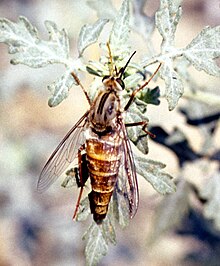Delhi Sands flower-loving fly
| Delhi Sands flower-loving fly | |
|---|---|

| |
| Scientific classification | |
| Kingdom: | |
| Phylum: | |
| Class: | |
| Order: | |
| Family: | |
| Genus: | |
| Species: | |
| Subspecies: | R. t. abdominalis
|
| Trinomial name | |
| Rhaphiomidas terminatus abdominalis Cazier, 1941
| |
The Delhi Sands flower-loving fly (Rhaphiomidas terminatus abdominalis) is a mydid fly in the genus Rhaphiomidas, and the only fly presently on the Endangered Species List.
This subspecies is restricted to the Delhi Sands formation, an area of ancient inland dunes of which only a few hundred acres out of more than 40 square miles (100 km2) remain. The rest largely now form much or all of the foundation on which the towns of Colton, Fontana, Rancho Cucamonga, California and Ontario, California are built. The adults are only active for a few weeks each year, feeding on flowers, in July, August and September.
This fly was emergency-listed by the United States Fish and Wildlife Service on September 23, 1993, and it has been an extremely contentious listing ever since. Political officials and news services from the region have repeatedly decried this fly as a disease-carrying pest, despite documentation that it is not.[citation needed] There have been repeated attempts by local officials to have the species de-listed. For example, Congressman Joe Baca proposed removing the Delhi Sands flower-loving fly off the Endangered Species List to encourage development.[1][2][3]
Residential and commercial development, agricultural conversion, sand mining, invasion by exotic species, dumping of cow manure and trash, and off-road vehicle use have resulted in significant loss and modification of the species' habitat. Estimates are that over 97% of the original habitat is already gone, and only a portion of what remains is suitable habitat for these flies.
There are an estimated 5–10 more species of insects endemic to the Delhi Sands formation, including newly discovered and still unnamed species of scarab beetle, sand roach, and Jerusalem cricket.[citation needed]
References
- ^ Baca bill aims to swat bothersome fly. Pe.com (2011-03-21). Retrieved on 2011-07-10.
- ^ Baca wants Delhi Sands Flower-loving flies off list. Sbsun.com. Retrieved on 2011-07-10.
- ^ Baca wants Delhi Sands Flower-loving flies off list. DailyBulletin.com (2010-03-09). Retrieved on 2011-07-10.

